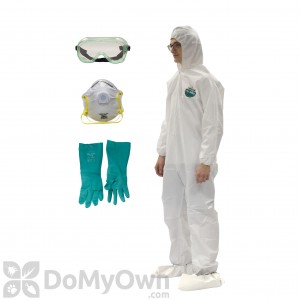Almost every customer who purchases our products wants to know "Are these pesticides safe to apply and are they safe to use around my family and pets?" The answer for almost every product we carry is yes, if you are using the product as specified on the label. When insecticides or pesticides are misused or proper precautions are not taken then safety issues will arise.
There are three routes of accidental pesticide entry into the body:
- Inhalation - Inhaling pesticides happens when a proper mask or respirator is not worn during the application process. Because of the small particle size of aerosols, fogs, mists, dusts, and ULV sprays, they are the most commonly inhaled pesticide formulations.
- Absorption - Absorbing insecticides through the skin occurs when skin to insecticide contact is made because of lack of protective clothing or because unwashed contaminated clothing is worn.
- Ingestion - Accidental ingestion usually occurs when the applicator fails to thoroughly wash his/her hands and then eats, drinks or smokes. Accidental ingestion also occurs when pesticides are stored improperly near food or drinks.
Here are some things you can do to avoid inhalation, absorption, and ingestion of pesticides or insecticides.
- FOLLOW THE PRODUCT LABEL. At Do My Own Pest Control we always emphasize the importance of following the label on the product that is being used. Only use at the recommended concentrations and only use where specified. Failure to follow the label instructions can lead to pest control failure and health and safety hazards.
- Wear protective gear. Again refer to the label to find out what type of protective gear or clothing is needed. Many labels specify that the applicator should wear long pants, long sleeves, shoes and socks, gloves, and a respirator. Other labels specify the addition of goggles or coveralls for extra protection. You should also consider the environment where the application will be made as well as the pest that is being treated. For instance if you are going to be doing a treatment in a crawlspace that is wet and muddy, you may want to wear coveralls even if the label does not specify it, or if you are treating for stinging insects you may want to consider donning a complete bee suit to avoid a possible attack.
- Allow only the applicator into application areas. Children, pets and other adults should remain out of treatment areas while the application is being applied and they should not return to the area until it has been properly vented and the spray is dry.
- Clean Up. Always thoroughly wash hands, arms, face and any other exposed skin after a pesticide application is completed or if stopping for a break. Change out of and wash clothing worn during the application process. Wash any equipment that was used to prevent inadvertently mixing chemicals or exposing ones self to pesticides. Clean up spills immediately, using a spill kit if necessary.
- Store and transport pesticides correctly. Read the label to find out how the product should be stored and transported. Most labels tell you to keep the products out of extreme heat and freezing temperatures and out of direct sunlight. Insecticides and pesticides should also be stored away from food and food products.
How toxic are pesticides?
The toxicity of pesticides or insecticides is directly related to type of chemical in the product and the pesticides formulation. Using the correct application procedures and taking the proper precautions should help eliminate or minimize the hazards related to using the product. The MSDS should be referred to when trying to determine pesticide safety.
Safety Products:
Unlined Rubber Gloves - Heavy duty unlined chemical resistant gloves
Nitrile Gloves - Disposable chemical resistant gloves
Tyvek Coveralls - Disposable chemical resistant that can be worn over clothing
Complete Bee Suit - features a comfortable and durable cotton/poly bee suit with elastic wrist and leg openings, square zipper veil, ventilated helmet and gloves.
Comfo Classic Respirator - half-mask respirator featuring a new SoftFeel face piece and a unique face-seal design that gives the wearer exceptional fit
Respirator Cartridges - The P100 Comfo Respirator Cartridges filter 99.97% of particulates in the air including aerosol particulates and fogging insecticides
Aab-Sorb 40 Gallon Spill Kit - 40 Gallon emergency spill kit to clean up water-based insecticides




